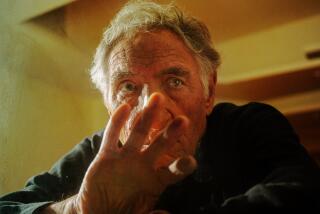Photographer shot indelible images for Life magazine
- Share via
Allan Grant, a Life magazine photographer who got the last photo shoot with Marilyn Monroe weeks before her death and the first pictures of Marina Oswald just hours after the assassination of President John F. Kennedy, has died. He was 88.
Grant died Feb. 1 of Parkinson’s-related pneumonia at his home in Brentwood, according to his wife, Karin.
In their glory days, photographers for magazines like Life had extraordinary access to the glamorous worlds of fashion and Hollywood as well as history-making events.
Grant photographed atom bomb tests in the Nevada desert in the early 1950s, as well as Howard Hughes’ memorable 1947 flight in the H-4 airplane that became known as the “Spruce Goose.” He shot the Academy Awards, photographing Audrey Hepburn and Grace Kelly poised backstage for the best actress announcement at the 1955 ceremonies.
Colleagues recalled that Grant was also a fine spot-news photographer and captured former Vice President Richard Nixon, dressed in slacks and a tie, atop his rented house hosing down the roof during the catastrophic Bel-Air fire of 1961.
Grant photographed Monroe at her home for a Life magazine profile that appeared in the magazine’s Aug. 3, 1962, issue. She died Aug. 5.
In a statement, Richard “Dick” Stolley, the Los Angeles bureau chief for Life magazine in 1963 who later served as the magazine’s managing editor and was founding managing editor of People, recalled Grant as “very handsome and glamorous, two virtues that made him popular in Hollywood.”
But, according to Stolley, Grant was “a newsman too.”
The biggest assignment of the photographer’s career came Nov. 22, 1963, the day Kennedy was shot in Dallas
After news of the shooting broke, Grant and several other Los Angeles-based staffers flew to Dallas on a commercial flight packed with journalists. Arriving that afternoon, Grant and reporter Thomas Thompson set out to find the family of the assassin, Lee Harvey Oswald.
Oswald’s Russian wife Marina, who spoke little English, was living at the home of Ruth Hyde Paine in the nearby town of Irving. Grant and Thompson discovered her there along with her two children and Oswald’s mother, Marguerite.
They stayed with the family all afternoon and eventually persuaded Marina, along with her two babies, Marguerite, Oswald’s brother Robert and Paine, who spoke Russian and acted as an interpreter, to go with them to Dallas. They put the family up in a hotel and promised to help them get rights to visit Oswald in jail. Grant continued to take pictures for their exclusive story.
Grant later told John Loengard in the book “Life Photographers: What They Saw” that when he left, he gave Marina some money, embraced her and wished her well.
“God, she was so confused by it all,” Grant recalled.
The next issue of Life had numerous photos of Jacqueline Kennedy and her children and just one small photo of Marina Oswald.
According to Grant’s wife, the photo and story of the Oswald family did not see print until years later, when many of the images were published in an obscure German magazine.
Grant was born Oct. 23, 1919, in New York City. He turned to photography as a teenager after trading a model airplane to another kid for a camera.
His early work was in a laboratory, where he printed the images of noted photographers, including Robert Capa and Alfred Eisenstaedt.
Grant’s first Life magazine assignment was as a freelancer in 1945 and involved a story about a Connecticut sailing school for kids. His photo made the cover and, 18 months later, his days of freelancing were over. He was hired by Life in 1946 and stayed with the magazine until the late 1960s.
After leaving Life, Grant produced educational documentaries. He received three Emmy nominations for his TV film “What Color Is the Wind?” -- based on a story about twin boys, one born blind, that had appeared in Life.
Grant told Loengard that during his shoot with Monroe, she was concerned about the lights.
“She asked me if the light was OK, and I said, ‘To tell you the truth, this is the first time I’ve done a portrait, and I really don’t know where the lights should be.’ She took that seriously. Her publicist said, ‘Allan, for God’s sake, don’t fool with Marilyn that way.’
“It’s a joke,” I said. “I’m sorry.”
In addition to his wife, Grant is survived by daughter Kristina, sons Richard and Ronald and three grandchildren.
Memorial services will be held at a later date.


